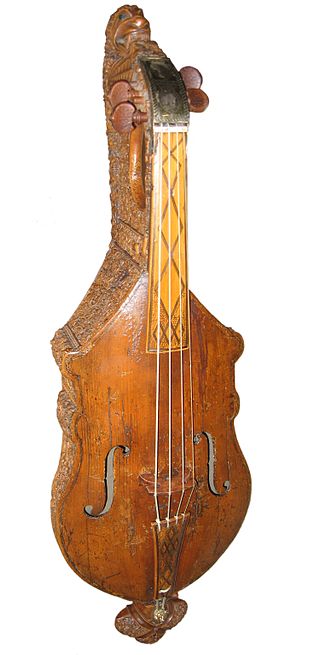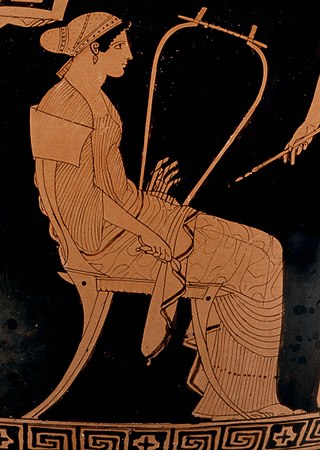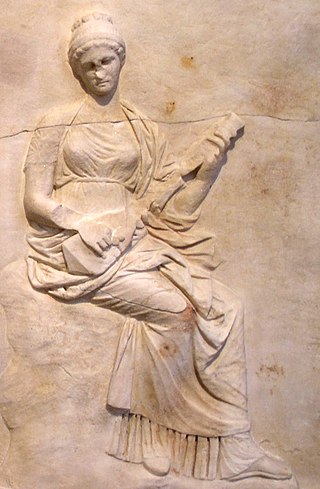
In musical instrument classification, string instruments, or chordophones, are musical instruments that produce sound from vibrating strings when a performer strums, plucks, strikes or sounds the strings in varying manners.

The lyre is a stringed musical instrument that is classified by Hornbostel–Sachs as a member of the lute family of instruments. In organology, a lyre is considered a yoke lute, since it is a lute in which the strings are attached to a yoke that lies in the same plane as the sound table, and consists of two arms and a crossbar.

The crwth, also called a crowd or rote or crotta, is a bowed lyre, a type of stringed instrument, associated particularly with Welsh music, now archaic but once widely played in Europe. Four historical examples have survived and are to be found in St Fagans National Museum of History (Cardiff); National Library of Wales (Aberystwyth); Warrington Museum & Art Gallery; and the Museum of Fine Arts, Boston (US).

Rebab is the name of several related string instruments that independently spread via Islamic trading routes over much of North Africa, Middle East, Central Asia, Southeast Asia, and parts of Europe. The instrument is typically bowed, but is sometimes plucked. It is one of the earliest known bowed instruments, named no later than the 8th century, and is the parent of many bowed and stringed instruments.

The harp lute, or dital harp, is a musical instrument that combines features of harp and lute and to increase its compass of the latter. It was invented in 1795 by Edward Light,.

The Guitar fiddle or Troubadour Fiddle is a modern name bestowed retroactively upon certain precursors of the violin possessing characteristics of both guitar and fiddle. The name guitar fiddle is intended to emphasize the fact that the instrument in the shape of the guitar, which during the Middle Ages represented the most perfect principle of construction for stringed instruments with necks, adopted at a certain period the use of the bow from instruments of a less perfect type, the rebab and its hybrids.

The organistrum is an early form of hurdy-gurdy. Generally considered the ancestor of later hurdy-gurdies, the organistrum differs substantially in that it was played by two individuals: one turned the crank while the other pulled the keys upward to change the musical pitch of the strings. In other examples a player pushed levers forward to create the notes.

The citole was a string musical instrument, closely associated with the medieval fiddles and commonly used from 1200–1350. It was known by other names in various languages: cedra, cetera, cetola, cetula, cistola, citola, citula, citera, chytara, cistole, cithar, cuitole, cythera, cythol, cytiole, cytolys, gytolle, sitole, sytholle, sytole, and zitol. Like the modern guitar, it was manipulated at the neck to get different notes, and picked or strummed with a plectrum. Although it was largely out of use by the late 14th century, the Italians "re-introduced it in modified form" in the 16th century as the cetra, and it may have influenced the development of the guitar as well. It was also a pioneering instrument in England, introducing the populace to necked, plucked instruments, giving people the concepts needed to quickly switch to the newly arriving lutes and gitterns. Two possible descendant instruments are the Portuguese guitar and the Corsican Cetera, both types of cittern.

The barbiton, or barbitos, is an ancient stringed instrument related to the lyre known from Greek and Roman classics.

The epigonion was an ancient stringed instrument, possibly a Greek harp mentioned in Athenaeus, probably a psaltery.

The pandura or pandore, an ancient Greek string instrument, belonged in the broad class of the lute and guitar instruments. Akkadians played similar instruments from the 3rd millennium BC. Ancient Greek artwork depicts such lutes from the 3rd or 4th century BC onward.

The cythara is a wide group of stringed instruments of medieval and Renaissance Europe, including not only the lyre and harp but also necked, string instruments. In fact, unless a medieval document gives an indication that it meant a necked instrument, then it likely was referring to a lyre. It was also spelled cithara or kithara and was Latin for the Greek lyre. However, lacking names for some stringed instruments from the medieval period, these have been referred to as fiddles and citharas/cytharas, both by medieval people and by modern researchers. The instruments are important as being ancestors to or influential in the development of a wide variety of European instruments, including fiddles, vielles, violas, citoles and guitars. Although not proven to be completely separate from the line of lute-family instruments that dominated Europe, arguments have been made that they represent a European-based tradition of instrument building, which was for a time separate from the lute-family instruments.

The kithara, Latinized as cithara, was an ancient Greek musical instrument in the yoke lutes family. It was a seven-stringed professional version of the lyre, which was regarded as a rustic, or folk instrument, appropriate for teaching music to beginners. As opposed to the simpler lyre, the cithara was primarily used by professional musicians, called kitharodes. In modern Greek, the word kithara has come to mean "guitar", a word which etymologically stems from kithara.

The Byzantine lyra or lira was a medieval bowed string musical instrument in the Byzantine Empire. In its popular form, the lyra was a pear-shaped instrument with three to five strings, held upright and played by stopping the strings from the side with the fingertips and fingernails. The oldest known depiction of the instrument is on a Byzantine ivory casket, dated to circa 900–1100 AD, preserved in the Bargello in Florence. Modern variants of the lyra are still played throughout the Balkans and in areas surrounding the Black Sea, including Greece, Crete, Karpathos, Albania, Montenegro, Serbia, Bulgaria, North Macedonia, Croatia, Italy, Turkey and Armenia.

The sambuca was an ancient stringed instrument of Asiatic origin. The term sambuca is also applied to a number of other instruments.

A tromba marina, marine trumpet or nuns' fiddle, is a triangular bowed string instrument used in medieval and Renaissance Europe that was highly popular in the 15th century in England and survived into the 18th century. The tromba marina consists of a body and neck in the shape of a truncated cone resting on a triangular base. It is usually four to seven feet long, and is a monochord. It is played without stopping the string, but playing natural harmonics by lightly touching the string with the thumb at nodal points. Its name comes from its trumpet like sound due to the unusual construction of the bridge, and the resemblance of its contour to the marine speaking-trumpet of the Middle Ages.

Lutes are stringed musical instruments that include a body and "a neck which serves both as a handle and as a means of stretching the strings beyond the body".
Yoke lutes, commonly called lyres, are a class of string instruments, subfamily of lutes, indicated with the codes 321.21 and 321.22 in the Hornbostel–Sachs classification.

The Anglo-Saxon lyre, also known as the Germanic lyre, a rotta, or the Viking lyre, is a large plucked and strummed lyre that was played in Anglo-Saxon England, and more widely, in Germanic regions of northwestern Europe. The oldest lyre found in England dates before 450 AD and the most recent dates to the 10th century. The Anglo-Saxon lyre is depicted in several illustrations and mentioned in Anglo-Saxon literature and poetry. Despite this, knowledge of the instrument was largely forgotten until the 19th century when two lyres were found in cemetery excavations in southwest Germany. The archaeological excavation at Sutton Hoo in 1939, and the correct reconstruction of the lyre in 1970, brought about the realisation that the lyre was "the typical early Germanic stringed instrument."

During the 11th to 15th century A.D., rotte (German) or rota (Spanish) referred to a triangular psaltery with at least 10 strings, held like a harp in front of the musician. The playing position was different from other psalteries, as the Rotte might be held like a harp, leaned sideways, or rested on the lap. Two styles of rotte have been inferred from images: the first is a triangular box with strings on one side, the other has strings on both sides. The instruments are shown played with both plectrum and with fingers.
























